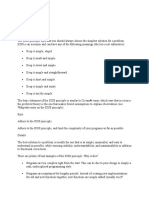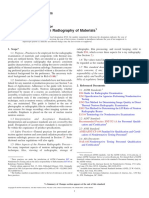Tuple In Python
Uploaded by
alamk765432Tuple In Python
Uploaded by
alamk765432Tuples in Python
Creating Tuples
Deleting Tuples
Accessing Elements in Tuple
Tuples Operations: Concatenation, Repetation, Membership, Iteration.
Built in Tuples functions and methods.
Introduction to Tuple in Python
Python used 4 built-in data types to store collections of data like Tuple, List, Set, and Dictionary. These all
build in types has different qualities and usage.
A tuple is created by placing all the items (elements) inside parentheses (), separated by commas.
The parentheses are optional, however, it is a good practice to use them.
A tuple can have any number of items and they may be of different types (integer, float, list, string, etc.)
A tuple is a collection of objects which is ordered and immutable (unchangeable).
Tuples are sequences of elements, just like lists.
Tuples are used to store multiple items in a single variable.
When we create tuple with a single element, make sure to add a comma after the element.
The tuple are immutable, means we cannot change the elements of a tuple once assigned.
An element in a tuple cannot be removed or replaced (change).
Tuple is stored in a single block of memory, so creating a tuple is faster than creating a list.
Tuple makes your code safer because data in tuple is “write-protected”.
Tuples are iterable so it contains an index and an item from the original iterable.
Tuples can be used + (concatenation) and * (repetition) operators and returns a new tuple.
Benefits of Tuple
o It is very easy to create tuple and store data.
o Tuple can give the programmer and the interpreter a hint that the data should not be changed.
o Tuples are commonly used as the equivalent of a dictionary without keys to store data.
o Reading data is simpler when tuples are stored inside a list.
Slicing and Indexing of Tuple
o To index or slice a tuple you need to use the [] operator on the tuple.
o When indexing a tuple.
o Provice Positive Indexing: if you provide a positive integer, it fetches that index from
the tuple counting from the left.
o Negative indexing: if you provide a negative integer, It fetches that index from the tuple counting
from the right.
Tuples can be nested.
o Tuples can contain other compound objects, including lists, dictionaries, and other tuples.
Hence, tuples can be nested inside of other tuples.
Subject: Data Structure Print Date: [22/Apr/21], Page 1 of 8
Basic operations with Tuples.
o Accessing Values in Tuples: To access values in tuple, use the square brackets for slicing
along with the index or indices to obtain the value available at that index.
o Updating Tuples: Tuples are immutable, which means you cannot update or change the values
of tuple elements. But we can concatenate 2 tuples and it returns 3rd Tuple.
o Delete Tuple: We can delete the tuple.
Creating tuple in python?
Example to create empty tuple.
Example to create tuple with single element (with and without paranthesis).
Example to create tuple with multiple element (with and without paranthesis).
Example to create Nesting of Touples.
Subject: Data Structure Print Date: [22/Apr/21], Page 2 of 8
Example to show we can not change the values of Tuple.
Example of Creating Tuple with Slicing.
o Positive Indexing
o
o Negative Indexing
Subject: Data Structure Print Date: [22/Apr/21], Page 3 of 8
Deleting Tuple in Python.
Example to access individual element using positive or negative indexing.
TUPLE OPERATIONS
Tuple Concatenation:
Subject: Data Structure Print Date: [22/Apr/21], Page 4 of 8
Example to create new tuple by concatenating Touples.
Tuple Repetation
Example to create Repetition of Touples.
Membership Operation on Tuple,
o Membership operators are used to validate the membership of a value in a sequence such as
strings, lists or tuples.
o Python has two membership operators – “in” and “not in”.
o Membership Operator ( in ):
o The in operator is used to check if an element is present in a sequence or not. It returns True if
element is pesent, otherwise return False.
o Example to find 100 in Tuple1.
o Example to find 30 in Tuple1
Subject: Data Structure Print Date: [22/Apr/21], Page 5 of 8
o Membership Operator ( not in ):
o The not in operator is used to check if an element is present in a sequence or not. It returns True
if element is not pesent, otherwise return False.
Tuple Iteration.
o We can iterate the tuple using for loop .
Built in Tuples functions.
o len() function :
This function returns the number of elements in a tuple.
Syntax: len( tuple )
o max() function :
This function returns the maximum number from tuple.
Syntax: max( tuple )
o min() function :
This function returns the minimum number from tuple.
Syntax: min( tuple )
o sum() function :
This function returns the sum of all elements of tuple.
Syntax: sum( tuple )
Subject: Data Structure Print Date: [22/Apr/21], Page 6 of 8
Built In Tuple Methods…
count() method :
This method returns the number of times a specified value appears in the tuple.
Syntax: tuple1.count( value )
index() method :
This method returns the first occurance of specified value. If value found, then it returns its index
position, and if not found, then it raised an exception.
Syntax: tuple1.index( value )
Subject: Data Structure Print Date: [22/Apr/21], Page 7 of 8
Exception details if item not found in tuple when we call index method.
Subject: Data Structure Print Date: [22/Apr/21], Page 8 of 8
You might also like
- Hourglass Workout Program by Luisagiuliet 276% (21)Hourglass Workout Program by Luisagiuliet 251 pages
- Read People Like A Book by Patrick King-Edited58% (81)Read People Like A Book by Patrick King-Edited12 pages
- Livingood, Blake - Livingood Daily Your 21-Day Guide To Experience Real Health77% (13)Livingood, Blake - Livingood Daily Your 21-Day Guide To Experience Real Health260 pages
- Donald Trump & Jeffrey Epstein Rape Lawsuit and Affidavits83% (1016)Donald Trump & Jeffrey Epstein Rape Lawsuit and Affidavits13 pages
- The 36 Questions That Lead To Love - The New York Times94% (34)The 36 Questions That Lead To Love - The New York Times3 pages
- The 36 Questions That Lead To Love - The New York Times95% (21)The 36 Questions That Lead To Love - The New York Times3 pages
- 14 Easiest & Hardest Muscles To Build (Ranked With Solutions)100% (8)14 Easiest & Hardest Muscles To Build (Ranked With Solutions)27 pages
- Jeffrey Epstein39s Little Black Book Unredacted PDF75% (12)Jeffrey Epstein39s Little Black Book Unredacted PDF95 pages
- The 4 Hour Workweek, Expanded and Updated by Timothy Ferriss - Excerpt23% (954)The 4 Hour Workweek, Expanded and Updated by Timothy Ferriss - Excerpt38 pages
- Ch12. Tuples Notes With Question AnswersNo ratings yetCh12. Tuples Notes With Question Answers22 pages
- CH2. Python Revision Tour - II: Cbse - Class - Xii Computer Science With Python (NEW) (Subject Code: 083)No ratings yetCH2. Python Revision Tour - II: Cbse - Class - Xii Computer Science With Python (NEW) (Subject Code: 083)18 pages
- PYTHON REVISION TOUR II Study Material by Kshama RautNo ratings yetPYTHON REVISION TOUR II Study Material by Kshama Raut7 pages
- Python Notes 11 Dictionary Tuples and Sets 1664121924No ratings yetPython Notes 11 Dictionary Tuples and Sets 166412192421 pages
- ReactNativeBlobUtilTmp_f94lpccjf3cgbrz3afhov7No ratings yetReactNativeBlobUtilTmp_f94lpccjf3cgbrz3afhov725 pages
- A Study On SHG-Bank Linkage and Status of MFI in BiharNo ratings yetA Study On SHG-Bank Linkage and Status of MFI in Bihar196 pages
- Significantly Regulated Organizations Added in February 2017No ratings yetSignificantly Regulated Organizations Added in February 201710 pages
- 25 Body Idioms: Vocabulary & Pronunciation Lesson & QuizNo ratings yet25 Body Idioms: Vocabulary & Pronunciation Lesson & Quiz4 pages
- Sequencing Problems Processing N Jobs Through M Machines Problem Example PDF100% (1)Sequencing Problems Processing N Jobs Through M Machines Problem Example PDF2 pages
- Ey Top 10 Business Risks and Opportunities For Mining and Metals in 2023No ratings yetEy Top 10 Business Risks and Opportunities For Mining and Metals in 202356 pages
- Thomas Hobbes Leviathan 1st Edition Noel Malcolm All Chapters Instant DownloadNo ratings yetThomas Hobbes Leviathan 1st Edition Noel Malcolm All Chapters Instant Download77 pages
- Big Data Analytics in Mobile Cellular NetworksNo ratings yetBig Data Analytics in Mobile Cellular Networks29 pages
- Competitive strategies-performance nexus and the mediating role of enterprise risk management practices: a multi-group analysis for fully fledged Islamic banks and conventional banks with Islamic window in PakistanNo ratings yetCompetitive strategies-performance nexus and the mediating role of enterprise risk management practices: a multi-group analysis for fully fledged Islamic banks and conventional banks with Islamic window in Pakistan22 pages
- 1.1 Introduction, Water Demand - 21CV43No ratings yet1.1 Introduction, Water Demand - 21CV4316 pages
- Epigenetic Regulation in Plants: Ryza Aditya Priatama (리자 아디티아)No ratings yetEpigenetic Regulation in Plants: Ryza Aditya Priatama (리자 아디티아)30 pages
- C264 Application: Modular Remote Terminal UnitNo ratings yetC264 Application: Modular Remote Terminal Unit4 pages
- Fdflow A Fortran 77 Solver For 2d Incomp FlowNo ratings yetFdflow A Fortran 77 Solver For 2d Incomp Flow27 pages























































































































